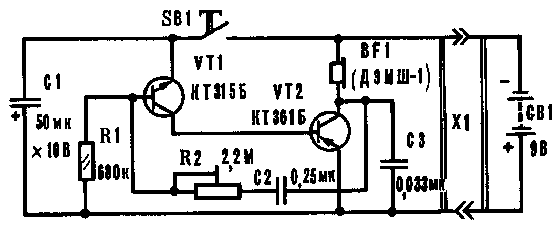The device which is schematically shown in Fig. 1, produces a complex audio signal, resembling a bird singing. The basis for it was somewhat unusual asymmetrical waiting multivibrator assembled on two silicon bipolar transistors different conductivity. Power source GB1 (battery "Emery") through connector X1 is permanently connected to the cascade transistor VT2, which separated from the first cascade transistor VT1 normally open button SB1. The feature of the device is the presence of three time-setting circuits, what, in fact, due to the nature of the sound effect. The simulator there is no General power switch, since the current consumption in the standby mode is less than 0.1 μa, which is much less current self-discharge of the battery.
Device works well. You only click on the button SB1, and the capacitor C1 is charged up to the voltage of the battery GB1. After releasing the button, the capacitor will power the transistor VT1. It will open, and through its transition collector-emitter current to flow base VT2, which will also open. Then comes into operation the RC-chain the positive feedback made up of resistor R2 and capacitor C2, and the generator is excited. Since the input of the generator relative to high resistance and is connected in series with a capacitor C2 and a resistor R2 has a lot of resistance, followed by a pulse of current significant duration. He, in turn, will be filled with the "pause" more short pulses whose frequency is within the audio range. These oscillations arise due to the presence of a parallel LC-circuit, consists of an inductance winding primer BF1, his own capacity and the capacitance of the capacitor C3 included AC parallel the winding BF1.
Due to the nonlinearity of the process of charge-discharge of capacitors C2 and C3 the sound vibrations will be additionally modulated by frequency and the amplitude. The result is a sound that can be played on a phone BF1 as a whistle, which continuously changes the tone, and then dropped - followed by a pause.

Fig. 1
After discharge of capacitor C2 begins a new the cycle of the charge - generating resumes. With each subsequent sound in descending order of voltage on the capacitor C1 whistling melody becomes different, often alternated by clicking characteristic birdsong and the volume will gradually decrease. At the end of "trills" heard a few quiet, gentle, evanescent whistles. Then the voltage on the base of VT1 will be below the threshold of opening (about 0.6-0.7 V), both galvanically connected transistor are closed, and the sound stops.
After some time the capacitor C1 is fully discharged (through its own internal resistance, resistor R1, the transistor VT1 and VT2 emitter junction) formed by the elements R1, S1, VT1 circuit is connected between the base and the emitter transistor VT2, the more it pajapita and thereby the high efficiency of the device in the standby mode. Work simulator resume by pressing again the button.
In the device, you can use transistors series CT, CT, CT, CT, KT315, CT, CT (VT1); CT, CT, CT, CT, KT361 (VT2) with the static transmission coefficient current not less than 30. The resistor R1 of any compact, for example MLT-0,125, a trimmer - SPO-0,4, CP3-9a. Capacitors C2, C3 - MBM (KLS, K10-7V), C1-oxide, for example K50-6. Phone BF1 - a primer DAMS-1, miniature "earphone" TM-2A (remove the plastic nozzle at the hearing tube) or other, but not necessarily electromagnetic, with a coil resistance of 200 Ohms; button KM1-1 or MP3.
The establishment is to select the position of the engine trimmer, which reproduces the desired sound effect.
The nature of the "singing" it is easy to change, picking up experienced by the following elements: C1 within 20-100 UF (defines the General the duration of the sound), C2 in the range of 0.1-1 UF (duration each individual sound). In addition, C2 and R1 (in the range of 470 ohms- 2,2 MOhm) determine the duration of the pauses between the first and subsequent sounds. Timbre coloration of sounds depends on the capacitance of the capacitor C3 1000 pF-0.1 µf).
Author; E. Sawicki, Korosten, Zhitomir region; Publication: www.cxem.net






